Resellos on sábanas - Sonora and North West Mexico
Originally the Governor of Sonora, José María Maytorena, had not accepted the sábanas and, according to the Douglas Daily Dispatch, had issued a decree[text needed] forbidding them though this was immediately countermanded by CarranzaDouglas Daily Dispatch, 13 February 1914. On 16 January 1914 the government told the Comisario de Policía at Agua Prieta that Chihuahua notes were not forced, but understood that the Tesorería General de la Federación was changing themAGHES, Oficialidad Mayor, tomo 2993 telegram Oficio Primer, Hermosillo to Comisario de Policía, Naco, 16 January 1914. On 8 February in reply to a query, interim Governor Randall told the Presidente Municipal of Nacozari that Chihuahua notes were not of forced circulation in the stateAGHES, Oficialidad Mayor, tomo 2993 telegram Randall, Hermosillo to Presidente Municipal, Nacozari, 8 February 1914 and three days later Carranza’s agent in Agua Prieta, Yves G. Lelevier, told him that the Oficinas Recaudadores had received instructions from Hermosillo to refuse Chihuahua notesCEHM, Fondo MVIII telegram Lelevier, Agua Prieta to Carranza, Culiacán, 11 February 1914.
As the notes started appearing in the areas adjacent to the Chihuahuan border, Maytorena wrote to Carranza on 11 February 1914 for advice and was told that they were to be of forced circulationCEHM, Fondo MVIII telegram Maytorena, Hermosillo to Carranza, Culiacán, 11 February 1914; Douglas Daily Dispatch, 13 February 1914. Carranza’s decree of 28 February forced acceptance of the various state issues so should have resolved the matter. However, in late February both El Paso del Norte and El Correo del Bravo, in El Paso, reported that Maytorena had prohibited the circulation of Chihuahua notes, and Maytorena had to write to Villa to deny itAGHES, Oficialidad Mayor, tomo 2993 telegrams Maytorena, Hermosillo to Villa, Ciudad Juárez and the editor of El Correo del Bravo, El Paso, 20 February 1914.
On 16 March Carranza, in response to another message, told Levelier that he had ordered that Chihuahua notes should be accepted in circulation in SonoraCEHM, Fondo MVIII telegram Carranza, Colonia Oaxaca, Son. to Lelevier, Agua Prieta, 16 March 1914. However, on 30 March Serapio Aguirre, Carranza’s secretary of the treasury, instructed Constitutionalist officials at Agua Prieta to stop the circulation of Villista currency, and to transmit this order to all other insurgent officials in Sonora. The principal reason for the order was said to be the issuance by counterfeiters of bogus “Villa bills,” amounting to 1,000,000 pesosEl Paso Herald, 1 April 1914: Albuquerque Journal, 1 April 1914: New York Times, 1 April 1914: Vida Nueva, 3 April 1914. The next day Maytorena telegraphed the Secretario de Gobernacíon, Rafael Zubarán Capmany, at Ciudad Juárez, relaying the Comisionado de Policía in Agua Prieta’s query, and asking whether the notes were of forced circulation. On 1 April Zubarán Capmany replied that Carranza had not issued any disposition and that the notes were of forced circulation in all the territories dominated by the Constitutionalists. If there were any local difficulties, this was due to attempts to avoid the circulation of counterfeit issuesAHSDN, exp. Xl/481.5/271, ff. 168-169. Positive assurances were given that the Villa money that people possessed would be redeemed with notes of the new issue currently being printed and expected from New York within the next two weeksTucson Daily Citizen, 31 March 1914: El Paso Herald, 1 April 1914. On 8 April 1914 it was reported that the Oficina del Timbre had received orders from the Administración Principal in Hermosillo not to accept Chihuahua notes, so it seemed difficult to force the public to accept themCEHM, Fondo MVIII telegram Alfonso González, Alamos to Carranza, Ciudad Juárez, 8 April 1914.
Matters changed, however, when Maytorena disowned Carranza and threw in his lot with Villa.
On 30 January 1915 the Sonora state government issued its circular with instructions (from Chihuahua) on forged sábanas and the various offices reacted accordingly with the Oficinas de Rentas accepting payment, and authorities forcing their circulation in accordance with these instructions. In February 1915 a Chihuahuan official (comisionado del Gobierno del Estado de Chihuahua), probabaly Remigio Montoya, arrived with a commission to revalidate genuine notes and invalidated counterfeit ones. Inevitably he caused confusion when he rejected notes that had previously been considered authentic. By April the Oficinas de Rentas were sending in notes, either presumed to be false or marked ‘FALSO’, which employees had been receiving and now wanted to exchangeAGHES, Oficialidad Mayor, tomo 3024, letter Tesorero General Int. Contabilidad 1187 to Gobernador, 15 April 1915. On 20 April the governor told the Tesorero to exchange the notes that had been declared counterfeit, so long as it benefited only the poorAGHES, Oficialidad Mayor, tomo 3024.
On 20 April Sahuaripa asked for someone with authority to restamp notes that were of forced circulation as the public were refusing themAGHES, Oficialidad Mayor, tomo 3024. On 21 April Sonora’s interim Tesorero General, Jesús Ramos, said that the process of revision and restamping that had been taking place in Hermosillo, Nogales and Guaymas had revealed a large number of forgeries. Because of this Governor Maytorena had agreed that between 27 April and 10 May the poorer classes could exchange any counterfeit money at the Treasury’s officesAGHES, Oficialidad Mayor, tomo 3024.
Though we know of the following resellos they are in fact extremely uncommon on sábanas, indicating the fact that this issue was never widely circulated in Sonora:
Cananea – Prefectura del Distrito de Arizpe
A large round violet rubber stamp with the legend ‘Prefectura del Distrito de Arizpe, Estado de Sonora, Mexico’.
Magdalena – Prefectura del Distrito
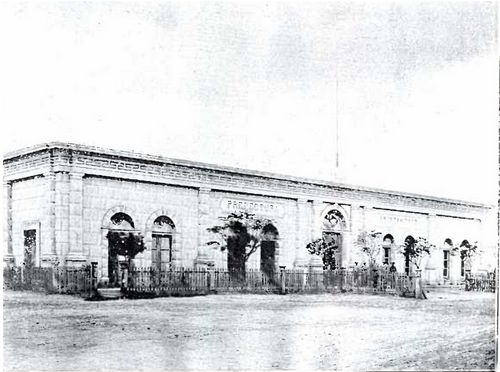
Prefectura, Magdalena
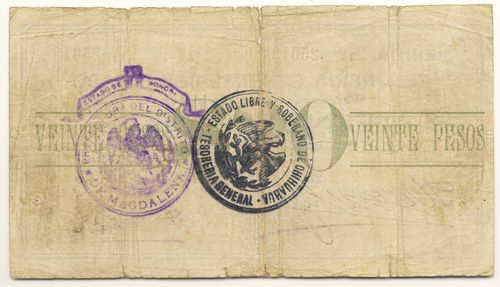
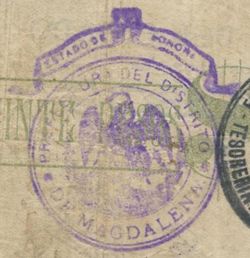 ‘PREFECTURA DEL DISTRITO DE MAGDALENA’ in circle (41mm) with scroll 'ESTADO DE SONORA’ above.
‘PREFECTURA DEL DISTRITO DE MAGDALENA’ in circle (41mm) with scroll 'ESTADO DE SONORA’ above.
Magdalena – Presidencia Municipal
On 23 March 1915 Juan Lung Tain y CompañíaJuan Lung Tain ran an import/export and commission company with its headquarters in Guaymas and branches in Magdalena, Santa Ana, Navojoa, Estación Llano and Nogales. In Nogales he owned the “La Mariposa” store. of Magdalena handed in $500 in sábanas to be sent to Chihuahua. The notes were checked and stamped with the seal of the Presidencia Municipal. In Chihuahua $265 were found to be bogus, marked accordingly, and returned to the company. The office in Magdalena reported that it was stamping any note that agreed with the instructions received from Hermosillo but wanted new instructions and felt that an inspector would be helpfulAGHES, Oficialidad Mayor, tomo 3024. On 23 February 1915 the Tesorero Municipal of Saric reported that everyone was refusing to accept either of the Chihuahua issues. On 15 April he reported that the problem continued since each day they received new instructions about counterfeit notes. Even some notes that had been stamped by the Aduana Fronteriza de Nogales which he had received had been returned. His report does not mean that the notes were necessarily forged, merely unacceptable. Was he referring to sábanas with the Aduana resello (unreported) or unfamiliar dos caritas?.
Nogales – Secretaría Particular
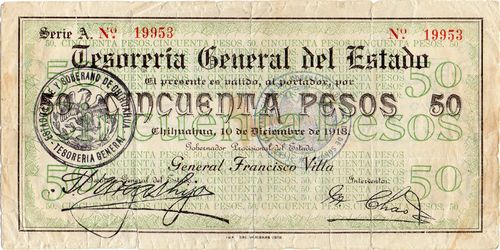
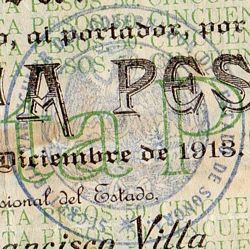 A large (39mm) round seal with eagle in centre and ‘SECRETARIA PARTICULAR DEL GOBERNADOR DEL ESTADO DE SONORA’.
A large (39mm) round seal with eagle in centre and ‘SECRETARIA PARTICULAR DEL GOBERNADOR DEL ESTADO DE SONORA’.
This resello was used in Nogales from 28 May 1915 by the inspector, Remigio MontoyaJMM papers, box 5, folder 12 Aviso al Público, 28 May 1915. It would appear that this seal was used not because of any connection with the Secretario Particular but merely because of a shortage of rubber stampsOn 15 May Maytorena wrote to the Agencia Financiera in Ciudad Juárez asking for six rubber stamps reading “Comision Revisadora de Billetes del Estado de Sonora”. JMM papers, box 5, folder 10.
Nogales - Fuerzas del Estado
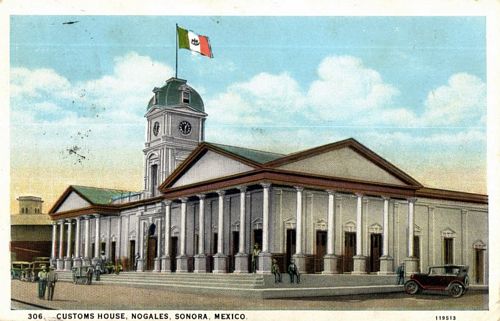
A large 42mm round black stamp with eagle in centre and ‘FUERZAS DEL ESTADO DE SONORA. - DETALL GENERAL’ around with a ribbon inscribed ‘REPUBLICA MEXICANA’ above.
This stamp was used in Nogales from March 1915Vida Nueva, 9 March 1915. On 16 March 1915 Governor Maytorena issued a notice informing the public that he had commissioned Francisco J. CazebudCabezud started on 12 March 1915 (ABCS, Gobernación, vol. 642, exp. 150) and resigned his post, on taking up another commission, on 29 May 1915. During his tenure he revalidated $1, 387,631 ($166,800 in March, $714,196 in April and $506,635 in May (JMM papers, box 5, folder 12, letter Cabezud to Maytorena, 26 May 1915), including some one peso sábanas (or possibly dos caritas) to oversee the revision and revalidation of notes. Therefore notes sealed until the previous day with the “Administración de la Aduana de Nogales, Sonora” and the initials “R. M.” were valid, and henceforth notes would have a “República Mexicana. Fuerzas del Estado de Sonora. Detalle General” seal and the initials “F. J. C.”Prensa, San Antonio, 19 March 1915.
On 17 May Maytorena wrote to Cabezud authorising him to revalidate sábanas until told otherwiseJMM papers, box 5, folder 11, item 5. Cabezud may have revalidated a few $1 sábanas.
Guaymas – Aduana Marítima
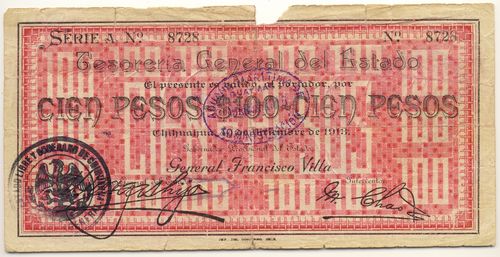
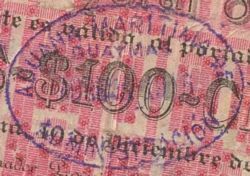 A 44mm blue oval rubber stamp with inscription ‘ADUANA MARITIMA DE GUAYMAS – ADMINISTRACION’ and date in centre.
A 44mm blue oval rubber stamp with inscription ‘ADUANA MARITIMA DE GUAYMAS – ADMINISTRACION’ and date in centre.
This was used between March and May 1915. It is known dated 31 May 1915 on one $100 note.
Guaymas – Prefectura del Distrito
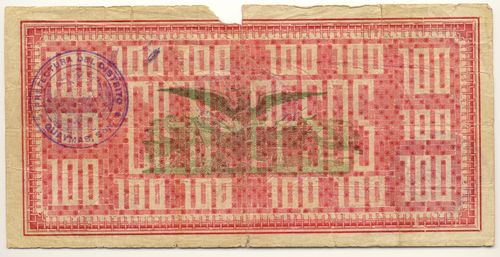
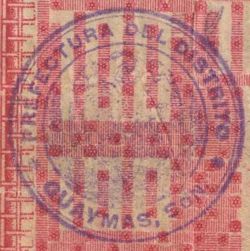 ‘PREFECTURA DEL DISTRITO - GUAYMAS, SON.’
‘PREFECTURA DEL DISTRITO - GUAYMAS, SON.’
This rare resello is also known on a $100 note.
Ensenada – Jefatura Política del Distrito Norte
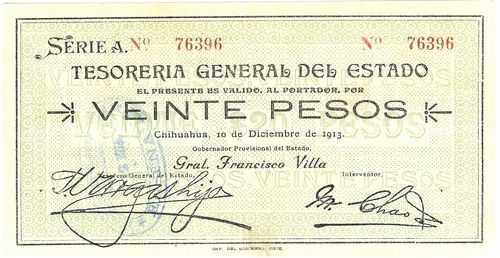
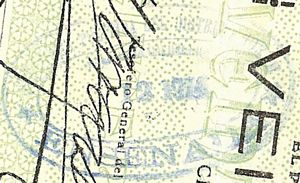 A 49mm blue oval stamp with ‘JEFATURA POLITICA DEL DISTRITO NORTE – ENSENADA’ and date in centre.
A 49mm blue oval stamp with ‘JEFATURA POLITICA DEL DISTRITO NORTE – ENSENADA’ and date in centre.
Ensenada, the third largest city in Baja California, is situated 116 kilometres south of Tijuana.
In October 1914 it was reported that more than $300,000 in Villista paper money had been sent to Baja California. The Chinese shopkeepers in Ensenada were closing their businesses rather than accepting this moneyPrensa, 11 October 1914.
Todos Santos - [ ]
On 24 July 1915 the acting Presidente Municipal of Todos Santos, A. Dominguez, reported that great difficulties were being caused because most of the currency in the locality lacked the resello of the Comandancia. He asked the Comandante Militar in La Paz to authorise his office or the Treasury to revalidate notes, and the same day the Comandante Militar authorised him to revalidate the following issues: those of Cornejo, the sábanas (Estado de Chihuahua emitido en 1913) and Monclova as long as they were genuine. He added that the Gobierno Provisional de México and Ejército Constitucionalista issues were of forced circuation without the need for revalidationABCS, Gobernación, vol. 642, exp. 150.
Tamazula – Sindicatura
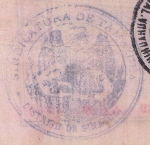 ‘SINDICATURA DE TAMAZULA – DISTRITO DE SINALOA’ with eagle in centre.
‘SINDICATURA DE TAMAZULA – DISTRITO DE SINALOA’ with eagle in centre.
Tamazula, in Sinaloa, is just off the main highway, about equidistant from Los Mochis and Culiacán.
